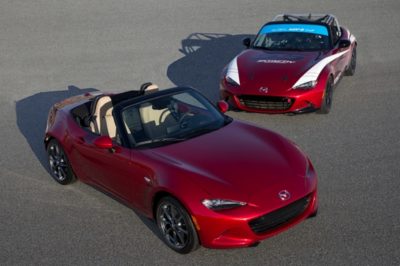The 2016 ND MX-5 is being developed into a Mazda-built-and-sold race car that will serve as the basis for MX-5 Cup
MazdaMotorsports.com has revealed much about what’s going into making the ND MX-5 a great racecar for the Mazda MX-5 Cup and Idemitsu Mazda MX-5 Cup Presented by BFGoodrich® Tires. One of the things that goes into making a good racer, though, doesn’t involve the modifications made to the base car. Rather, it’s the base car itself.
MX-5 Miatas have always made good racecars, whether that’s for a spec series like Spec Miata or MX-5 Cup, or classes where there are many different types of cars competing, from NASA Performance Touring to SCCA Super Touring and Production classes to Continental Tires SportsCar Challenge Street Tuner and Pirelli World Challenge Touring Car. But with the ND model that will arrive in dealer showrooms in a couple of months, the Mazda engineers have enhanced several bits to make it even better than its predecessor.
The NC was a great road car, a little roomier than the NB it replaced, without gaining too much weight. It has proven itself in both showroom sales and competition all over the globe. But some people feel that it lacked a certain feeling, a nimbleness and playfulness that the NA had. According to those that have driven the ND, that feeling is back.
“The ND MX-5 brings back memories of the original NA chassis,” says Andrew Carbonell, a racer in both Spec Miata and the Continental Tires series in a Freedom Autosport MX-5. Carbonell had the chance to drive one of the ND development cars at Mazda Raceway Laguna Seca, a track with which he is quite familiar, during the recent TUDOR/MX-5 Cup race weekend (where he won the Continental race with Liam Dwyer).
“By memories, I mean a lightweight chassis design that responds to the driver’s inputs with the touch of a finger,” he continues. “This nimble feel gave original Miata owners the sensation of being ‘one’ with the car. It gave them the confidence to push the limits through a corner. This is what the ND has brought back to life; a chassis so nimble you just have to think about what direction to go and it goes. The harder we drove around Mazda Raceway, the more the ND asked for it.”
A lot of that comes from reduced weight, but there’s another enhancement that contributes as well – revised suspension geometry.
“What we’ve found out with our [Kinematics and Compliance] data is they’ve enhanced rear toe for compression and on droop,” explains Glenn Long, principal of Long Road Racing, Mazda’s development partner on the Mazda MX-5 Cup car. “The rear comes to toe in, where in the past generation, it went to toe out with the five-link system. As the car starts to get light, it will be confidence inspiring instead of concerning.
“Also, the entire chassis, the lack of flexibility in the chassis, makes it a very stiff platform,” he continues. “There’s never been an issue with cowl rattle or anything like that in a Miata, but it takes it much further for that much more refinement as well. I think consumers will be impressed, and I know race car drivers will be, as well. They will be amazed at the transformation in the chassis.”
Long also points to some other enhancements, such as larger hubs and the very direct 6-speed transmission. He also notes that they plan to make no changes to the Brembo brakes that come as an option on the stock car, except for cooling.
All these improvements with the ND MX-5 will not only make the MX-5 Cup car an attractive proposition, but the road version should be very appealing to those who want to use the car for autocross competition or in a class such as SCCA Touring. Anything that reminds drivers of the original NA Miata and what made it such a good platform for competition is good news.


 ACCESSIBILITY
ACCESSIBILITY